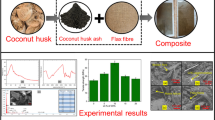Abstract
The increasing board densities resulting from increased final platten pressure applied during production (or maximum moulding pressure) provides the reason for observations of similar increases in the Young's modulus and the tensile strength, when two phenol formaldehyde bonded boards which are reinforced with 80% and 90% by volume of bagasse fibres are examined. Scanning electron microscopy was carried out on the fracture zones to differentiate between the effects of varying formaldehyde content. However, even with differences in the sizes of the cavities formed at fracture and in the board densities, the observed modulus versus density and strength versus density curves follow exponential trends. By using the exponential trends, a single best linear tensile strength versus Young's modulus relationship is deduced for these varying fibre to matrix combinations.
Similar content being viewed by others
References
A. R. Flower, Sci. Amer. 238-3 (1978) 42.
I. O. Salyer, G. L. Ball III, A. M, Usmani and D. W. Werkmeister, Development of Low Cost Roofing from Indigenous Materials of Developing Nations, AID/US (1975) pp. 31, 32, 190, 199.
A. A. Moslemi, “Particleboard”, Vol. 2 (Southern Illinois University Press, Carbondale and Edwardsville, 1974) p. 114.
Author information
Authors and Affiliations
Rights and permissions
About this article
Cite this article
McLaughlin, E.C. The strength of bagasse fibre-reinforced composites. J Mater Sci 15, 886–890 (1980). https://doi.org/10.1007/BF00552098
Received:
Accepted:
Issue Date:
DOI: https://doi.org/10.1007/BF00552098




